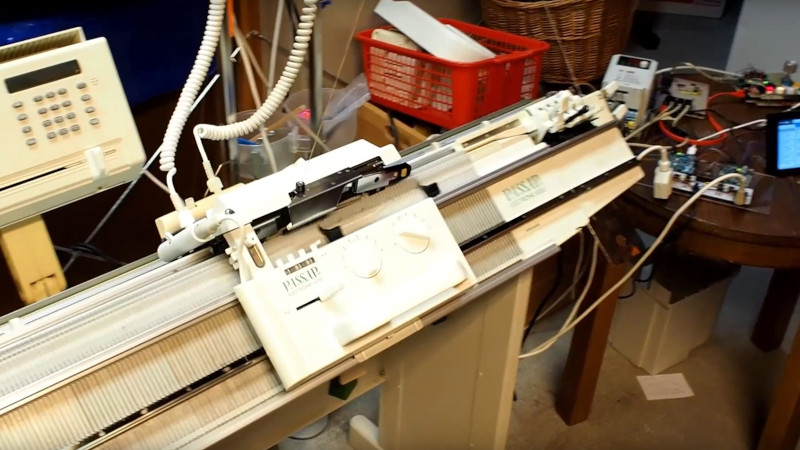Those of us who to textile work may own a sewing machine and even if we’re really into it and have the funds, an overlocker. But there’s another machine in that field that few of us will have, and that’s a knitting machine. These machines have a sliding carriage over a long array of needles, and even the cheaper ones are way more expensive than for example a pretty decent oscilloscope. [Irene Wolf] has a Passap E6000 computerised knitting machine that is by no means an inexpensive one, and she’s made significant improvement to it by giving it new brains, a new motor controller, and replacing the mechanical rear needle bed with a set of computerised ones from the front of another machine.
In her write-up she goes in depth into the arrangement of sensors and electromagnets that operate the machine. She started with a lot of inspiration from a project at Hackerspace Bamberg, but used all the available Passap sensors as inputs where they had used only one. She has two Arduino M0 boards handling the inputs and a Raspberry Pi with control and user interface, and has posted some videos of the system in action one of which we’ve placed below the break.
We probably wouldn’t have had the courage to fearlessly hack such a high-value machine, and we’re particularly impressed by the result. The write-up is particularly interesting not only for the work itself, but for the detailed insight it gives to the workings of these machines. The best news – she’s not finished and there will be more installments.
While you’re waiting for more, remember this is by no means the first hacked knitting machine we’ve brought you.
















“But there’s another machine in that field that few of us will have, and that’s a knitting machine. ”
Someone into quilting might.
Someone really into quilting may have a machine costing tens of thousands of dollars, and monopolizing a room sized in the hundreds of square feet, but a knitting machine isn’t generally part of the quilting toolset . . . in my experience.
You coulda gone with, “Robo polo-sweater knitter takes it to the necks level.” :-D
I think there were (much cheaper) unpowered knitting machines back in the day. I have dim memories of my mother getting a 2nd hand one in the 1980s. IIRC it had a manual carriage that the operator moved by hand. I’m not sure how the pattern was loaded. I remember that it used a finer, less “scratchy” wool than hand-knitted garments – in the 80s it was probably a blend of real wool with polyester or something…
Does anyone know more, or have some keywords to search for?
Yes, manual machines still exist. Prior to the electronic version some machines attached pattern leaders, used punch cards, or you could manually manipulate stitches by transfer tools to create your own patterns. The Passap featured above is a German machine. It has a non-electronic version (I think called Duomatic 80). There are Japanese versions of knitting machines as well. Some machines are single bed, some double bed. The double bed machines use the fine threat, as you mentioned, because the double thickness of that thread has to be able to be supported by the needles (without dropping stitches) . This brings us to the hook size of those needles. “Bulky” machines, which can take thicker threads, can make coats, jackets. The finer needled machines are great for baby gifts. There are attachments (Lacers) that one can use that make lace as well. Pattern books used to guide you as to how to set up (arrange) the needles for those machines to create the pictured patterns. I have to say that the (non-electronic) Passap could be a complicated machine for a first-time machine knitter, but it produces great results. I should say Amazing results. Other than the Passap, you could search for knitting machine models: Toyota, Knitking and alike. Note that single bed machines due to their nature can only accomplish “mock” ribbing. They can fake it, but the elasticity of the material is just not the same as real ribbing that is produced on a double bed machine. Pleasant Knittings!
That’s great info, thanks!